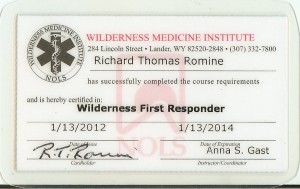What is a WFR?

A Wilderness First Responder, sometimes referred to as a “woofer,” is an individual trained and certified to provide extended emergency medical care in a wilderness setting. In comparison think of an urban first responder as focused on providing care during the “golden hour” – that critical hour of support before definitive care arrives, usually in the form of an ambulance carrying equipment, EMTs and paramedics. By definition a wilderness setting is more than an hour from care and depending on the remoteness of the setting and communication systems available, it may be days or weeks away. The nature of the wilderness activity may also limit the equipment and resources available. For example long distance backpackers, mountain climbers, and whitewater kayakers do not usually have readily available things like traction splints, backboards, spinal collars, blood pressure cuffs, or automated external defibrillators (AEDs). A Wilderness First Responder has to be very creative and resourceful when providing extended care.
Who is a WFR?
Woofer’s are usually individuals who are in leadership positions for outdoor adventures such as backpacking, mountain climbing, river rafting, skiing, and similar remote activities. They may be in roles such as trek leader, river guide, or ski patrol. Many reputable outdoor organizations now require Wilderness First Responder certification for their outdoor employees.
Who certifies WFRs?
There is no one certification body for Wilderness First Responders. A variety of medical and wilderness training organizations appear to have co-operated fairly well in creating training and testing standards. A typical WFR certification requires 72-80 hours of classroom and practice training, as well as both a written and practical exam. Although all certified individuals are called WFRs, the actual certification is controlled and tracked by the organization providing the training. Most require re-certification within 2-3 years, and not all organizations recognize the others certification for re-certification, although the major players (such as NOLS/WMI, SOLO, and WMA) appear to play nice.
What content is covered?
Each training provider’s website offers a detailed course outline, but some common themes include:
- Patient Assessment System
- CPR
- Head and Spine Injuries
- Bone and Joint Injuries
- Soft Tissue Injuries
- Shock
- Common Illnesses
- Treatment Planning
- Evacuation
Topics are covered with a combination of lecture and mock rescue practices, some of which are very elaborate and surprisingly realistic.
What is the difference between the organizations?
Because the schedule and location worked for me, I certified through NOLS/WMI. They are the only organization with which I have first hand experience, but during my research I found very strong advocates for each of the major players and some of the smaller ones. I suspect their curriculum and exams are similar. One piece of advice I got early on was to focus on the quality of the instructor, as that would potentially have a greater impact on my experience. Although I agree, I am not sure how practical that is to implement. I lucked out and ended up with an excellent instructor.
I recommend you do your own research, but to help you out I offer these potential major providers and their own website positioning statements:
- National Outdoor Leadership School – Wilderness Medicine Institute https://www.nols.edu “The nationally recognized standard in wilderness medicine education”
- Remote Medical International https://www.remotemedical.com “We are a medical and rescue services company specializing in remote areas.”
- Stonehearth Open Learning Opportunities (SOLO) https://www.soloschools.com/ “The oldest continuously operating school of wilderness medicine in the world.”
- Wilderness Medical Associates https://www.wildmed.com “The definitive wilderness course in medical leadership and critical thinking for outdoor, low-resource, and remote professionals and leaders.”
You should also consider quality smaller regional providers, although cross-organizational re-certification options may be more limited. As an example, in the San Francisco Bay Area Foster Calm has an excellent reputation. There are probably others in your area.
- Foster Calm https://www.fostercalm.com “First Aid and Leadership Training”
Conclusion
After experiencing through mock rescues and practice the wide variety of things that can go seriously wrong in the wilderness, I find myself wanting to add more and more things to my first aid kit. The reality, of course, is that my pack has limited space, but my brain is still relatively empty. The sign of a good “woofer,” I guess, is a continued focus on practice and skills rather than gear. I think being a Wilderness First Responder is a life long journey, but one I am willing to undertake. Besides my kids would probably say, a life long journey for me might not in fact be all that long. I may now be a First Responder, but somehow the my kids always have the last response.

One thought on “How To become a certified Wilderness First Responder (WFR)”